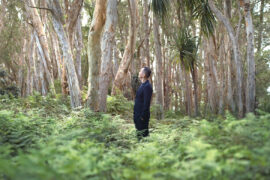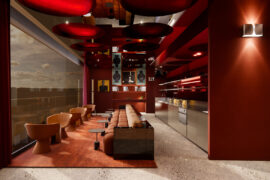In this comment piece republished from INDESIGN #88, Andrew Fong, studio lead at Allen Jack+Cottier Architects (AJC), discusses the ways in which museums are innovating in order to stay relevant.

July 20th, 2023
This comment piece was written by Andrew Fong, studio lead at AJC Architects. It originally appeared in INDESIGN #88, the ‘Education Outlook’ issue – get your copy here.
Many traditional institutions are seeing the trend of diminished visitation and therefore diminished funding. As a result, cultural spaces are undergoing a monumental shift as museums reimagine themselves to broaden their reach to new audiences. The future of museums is fast evolving through innovative initiatives in public programs, participatory culture, play and learning. So what role do museums play in our current context?
In the not-too-distant past, museums were synonymous with formal, adult-focused environments – a culture very much built around the protocol of ‘look but don’t touch’. There were some exceptions, such as the Exploratorium in San Francisco and Experimentarium in Hellerup, Denmark, or our beloved Questacon in ACT. However, these ‘niche’ museums are specifically targeted towards children and families. The sector is now evolving with many major cultural institutions positioning intergenerational and cross-cultural engagement at the forefront of their future vision.
Museums are looking through the lens of users to better engage visitors and reposition themselves as hubs for collaboration, knowledge and inspiration. Exciting times are ahead, with an array of innovative initiatives being put into play to make museums relevant again.
Related: One year at Bundanon Art Museum

Evolution of Public Programs
Powerhouse Parramatta demonstrates an unprecedented leap in how museums define themselves. Although the museum itself is currently under construction, the project has drawn enormous amounts of discussion and attention throughout the community and media over the past few years.
The Powerhouse is broadening its reach by supporting the western Sydney region with the development of this new major cultural institution. Powerhouse Parramatta will boast expansive floor space and international standard exhibition and programs spaces. What’s truly unique, however, is the inclusion of initiatives such as the Lang Walker Academy. This initiative will include world-class STEM education spaces with dorm rooms so students and teachers can stay overnight. The offering will better connect schools and tertiary education institutions with authentic and immersive learning and is particularly positive for those students and teachers who have long travel times or come from interstate or overseas. Knowledge, inspiration, resources and experiences which would not ordinarily be easily accessible, will now be on the doorstep of this rapidly growing region.
Urban Scale Intervention
Tasmania’s Museum of Old and New Art (MONA) has led the way in reinventing how people interact with museums and its wildly successful winter solstice festival, Dark Mofo, has been especially influential. With the first Dark Mofo held in 2013, this isn’t a new initiative, however, it’s taken the role and identity of museums to entirely new territories through provocative works and an urban-scale presence.
I had the chance to experience the multi-sensory, immersive nature of Dark Mofo. The festival offers installations and exhibitions in MONA’s main Berriedale location, however, it also extends its reach through its community, with initiatives such as the Winter Feast and intimate installations and performances throughout the city. Central Hobart came alive at night with intergenerational masses of locals and tourists slipping through alley ways, exploring industrial warehouses and discovering ominous, unexpected, yet intriguing provocations. It was a truly memorable experience and certainly the antithesis of what you might imagine a traditional museum offering to be.
Play in Museums
Takaharu and Yui Tezuka, founders of Tokyo-based architecture practice Tezuka Architects, have played an important role in the cultural sector with their design of Play! Museum, a museum in Tokyo entirely focused on play. Ambience, materiality and textural qualities within the museum are thoughtfully curated to offer joyful experiences for both children and adults through the making of objects, food, sound and movement. Takaharu is also the director of the museum and imparts his depth of knowledge on children and play to create memorable moments for families.
Play! Museum offers a dynamic range of installations centred around a ‘large dish’, which provides opportunities for children and adults to be messy and run around, or relax and reflect on a cushioned surface while listening to visitor performances on the grand piano. The museum offers a space for intuitive, unstructured play and as a result, visitors have the agency to lead their experience with pure imagination.
Long gone are the days when museums comprised solely of ‘cabinets of curiosity’ and art galleries were exclusively for the ‘elite’. While this recent shift may see the traditional museum buff stunned by radical change, we’re seeing a future that has its doors open, with infinite knowledge, innovation, creativity and culture accessible to all. There will always be a place in museums for the independent visitor to dwell, study and immerse themselves in static objects but we are in a much-needed period of change to keep our museums relevant and alive.
The blurring of lines between culture, community and learning invites visitors, whether aged nine or 99, to be engaged, interact, play, collaborate and ultimately learn the narratives of the past, present and future for generations to come. I am reinvigorated by the transformative shift ahead of us.
Find out more about INDESIGN #88 and susbcribe here!
AJC Architects
architectsajc.com
We think you might also like this On The Move column featuring Andrew Fong’s move to AJC Architects.
INDESIGN is on instagram
Follow @indesignlive
A searchable and comprehensive guide for specifying leading products and their suppliers
Keep up to date with the latest and greatest from our industry BFF's!

For a closer look behind the creative process, watch this video interview with Sebastian Nash, where he explores the making of King Living’s textile range – from fibre choices to design intent.

From the spark of an idea on the page to the launch of new pieces in a showroom is a journey every aspiring industrial and furnishing designer imagines making.

Merging two hotel identities in one landmark development, Hotel Indigo and Holiday Inn Little Collins capture the spirit of Melbourne through Buchan’s narrative-driven design – elevated by GROHE’s signature craftsmanship.

At Melbourne Design Week, Plus Studio brought together planners, designers and local government voices to unpack the realities of urban densification.

Merging two hotel identities in one landmark development, Hotel Indigo and Holiday Inn Little Collins capture the spirit of Melbourne through Buchan’s narrative-driven design – elevated by GROHE’s signature craftsmanship.
The internet never sleeps! Here's the stuff you might have missed

In Naturalizing Architecture, Takada moves beyond biomimicry to propose a regenerative vision for the urban environment.

COX Architecture uses saturated colour and hotel-style amenity across the historic St Peters location, designed for Coronation Property.